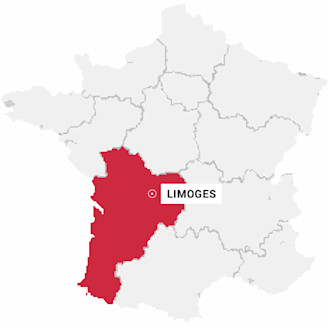
IGN Map


Although the emblem of Limoges is porcelain, the capital of firing art is also a « Town of Art and History » that...
In the Basque Country, at the heart of the Pyrénées Mountains, to the south of the region, close to the Spanish...
Leading department for tourism in France, Charente-Maritime offers a wealth of things to do and see. Here's a round up...
Sailing along the rivers of Nouvelle-Aquitaine is another way to enjoy your holidays, relaxed roaming along waterways...
A family day out that combines knowledge with fun to teach you everything you need to know about Limousin cattle.
Aymeric and Alexandra Broussaud took over the helm of a business that had been passed down over the generations. Here,...

IGN Map

Aerial Photos / IGN

Open Street Map

GUIDED TOURS ONLY IN JULY AND AUGUST
The traditional butcher's shop is open from early July to late August, Tuesday to Saturday, 2pm to 6pm.
Limited to 5 people.
Tours depart approximately every 30 minutes.
Located in the picturesque Boucherie district, it is one of 52 houses built in the early 13th century and dedicated to the butcher's trade.
Today, it's considered an eco-museum, showcasing the lives of the families who slaughtered, sold and cooked on the first floor, and lived upstairs, drying hundreds of sheep and pig skins in open-plan attics. Tools, photos of the street in full activity, writings and furnishings bear moving witness to the intimacy of a community faithful to its traditions, its faith and its trade.

A quick break while shopping?
A quick meal in town next to the office?
A relaxing drink?
Le Cap'tain is a bar and brasserie with a terrace open all year round right in the center of town. Come and enjoy a hot chocolate on a rainy day, or a snack with friends or family on the terrace.

The Limoges Aquarium celebrates its 30th anniversary this year! It?s a new season with a few new features.
Captain Axo remains true to form, accompanying visitors on their journey. Many anecdotes about the species that inhabit the waters of the five continents of the Earth await you! Throughout your visit, biologists will be on hand to listen to you, and to offer you the chance to watch the fish being fed.
Located in a former underground vaulted water reservoir belonging to the city of Limoges, you can observe native species (carp, perch, sturgeon, crayfish, etc.), as well as animals from lakes and rivers all over the world (rays, axolotls, shark fish, piranhas, discus, catfish, etc.), not forgetting the wonders of the marine world, with its multitude of astonishing colors and shapes

A Limoges institution since 1935, the history of the Garot cheese dairy continues with the reopening of La Maison du Fromage in November 2020. Here, gourmets will discover a selection of exceptional cheeses and Made in France delicatessen products. Visits to the maturing cellar can be booked in advance with La Maison du Fromage.
Take advantage of the opportunity to offer a gift card for this great experience.

Porcelain creations made and decorated by hand, tradition revisited! Cookie, fine gold, kiln blue, grand feu... Creations inspired by nature.

Lachaniette Porcelaines offers a selection of Limoges Porcelain, Crystal and Goldsmiths' and Silversmiths' wares from some of the world's greatest houses. The passion of three generations is brought together in this unique showroom, to give you a better understanding of this exceptional know-how through its history and evolution. You'll have access to a beautiful sales area (tableware, jewelry, home decor).